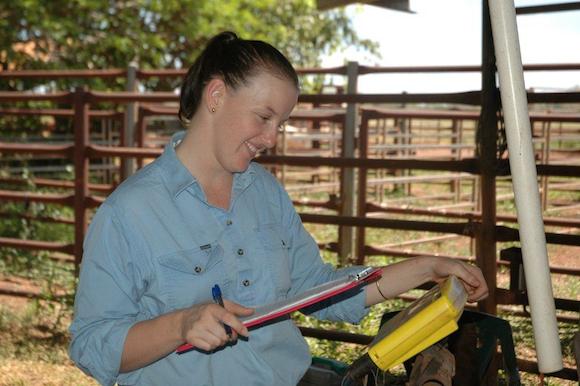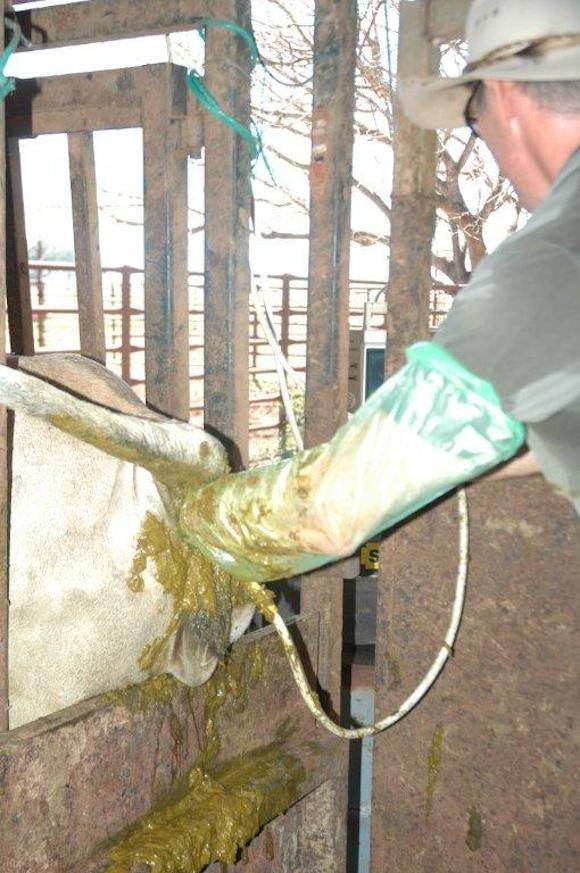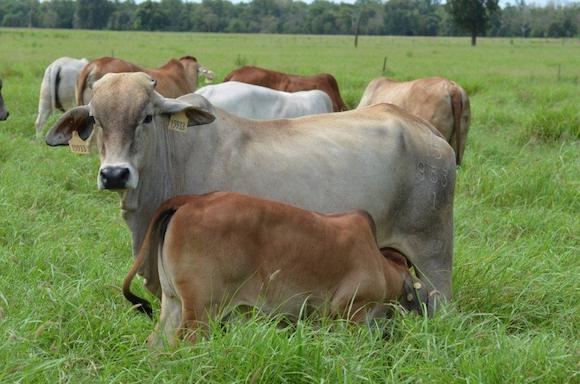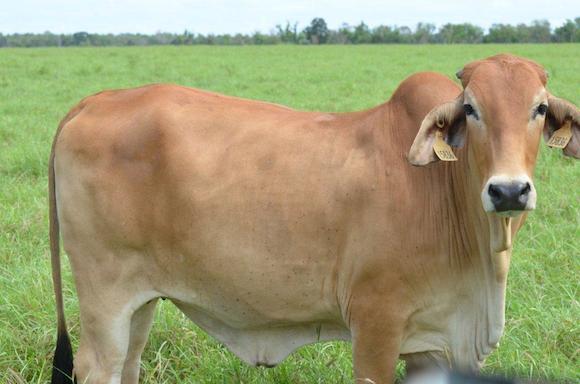Looking for lumps and bumps
Host: Katherine Research Station
Written by Trisha Cowley – Beef Cattle Extension Office and Whitney Dollemore – Beef Research Officer, both DPIF.
Snap! On goes a glove. Squirt! On goes some lubricant. The ultrasound machine is humming and it is time for a fertility check-up! But we are not in the maternity ward, we are in the cattle yards at Douglas Daly Research Farm in the NT and our patients are heifers!
Hi, it’s Trisha again! I had such fun with the last blog that I am back! Today I am co-writing with my colleague and good mate Whitney Dollemore, who is a Beef Research Officer with DPIF in Katherine. Whitney and I often work together, because Whitney does research into the genetics of fertility, while I deliver advice to producers on breeding and genetics. I reckon we make a pretty good team. Last time Whitney was on Central Station she was talking about the Super Cows. No they don’t wear blue and red lycra suits, but they sure are pretty special! Whitney manages the Super Cows (which I am super jealous about!), or Selected Brahmans as they are also known, which are a stud herd owned by the Department of Primary Industry and Fisheries which have been selected for fertility for the past 20 years. As expected, they are pretty fertile and significantly outperform commercial grade Brahmans run under the same conditions, in terms of calf output. Northern Australia is a pretty challenging place nutritionally and environmentally, so using genetics that produce more calves for the same inputs means a lot to the bottom line.
 Whitney hard at work collecting data on the Super Brahmans.
Whitney hard at work collecting data on the Super Brahmans.
Because these girls are so special, Whitney and I decided to talk about them again, but this time about a new project they are involved in, which is aiming to identify genetic markers for important fertility traits such as early onset of puberty and early resumption of cycling after calving. Research into the genetics of reproductive performance carried out by the Beef CRC found that age of puberty and resumption of cycling after calving in heifers were highly heritable traits. Further, the latter is correlated with lifetime reproductive output. That is, heifers that cycle sooner after calving also have more calves in their lifetime, compared to heifers that cycled later. They are our money makers, and we need to be able to identify them so that we can breed more! Research like this will allow us in the future to take a tail hair sample from a calf and find out if she is genetically likely to be a money maker or not, which is an exciting thought.
This week Whitney headed out to the Douglas Daly Research Farm to ovarian scan our Super heifers. Similar equipment is used to scan women during pregnancy, however this is a little more intrusive as we want a close look at their ovaries.
 Tim Schatz ovarian scanning a heifer.
Tim Schatz ovarian scanning a heifer.
The ovaries show us clues about the heifers’ reproductive status through little lumps and bumps that they grow which indicate whether a heifer is likely to get pregnant or not (i.e. is she cycling). We do this to determine the age of the heifer when she starts cycling (age of puberty) and to determine how soon after calving that a heifer starts to cycle again (i.e. how soon will she have another calf). Ovarian scanning is not a normal practice for commercial cattle stations. However it has an important role in research programs to identify animals with superior fertility traits.
If your cows are producing a calf every year then you can run less animals to produce the same amount of calves on the same area. If these animals aren’t identified they may be removed from the herd before having a chance to show their potential. For example, some producers select the heaviest heifers to be mated and sell the rest. However, some of the culled heifers may have actually been super cows, they just didn’t get the chance to shine! Currently, the only way to find these heifers involves mating them all and keeping those that get pregnant early. Pregnancy testing these heifers after their second mating will identify those that fell pregnant within four months of calving – and these are your gems – the heifers most likely to produce more calves in their lifetime. This is something you can’t see by looking at them, which is neatly shown in the two photos below. Both heifers are of similar age, condition, and type, but one has had two calves in a row, and the other has been a bit slack and only produced one! I know which one I want to be breeding bulls, and it’s not the slacker! Prior to mating, there was no way of knowing which heifer would perform outstandingly and which one would not. In the future however, research like this will help to find gene markers to do just that through a simple hair sample. More importantly, it will help to find the bulls which breed super cows!
 A three year old heifer that has had two calves in a row!
A three year old heifer that has had two calves in a row!
 Another three year old heifer that had one and then had a break!
Another three year old heifer that had one and then had a break!
So why would we want to find the bulls?? Whitney and I are all for women power, but in this case, the boys are more important! Now before you heatedly close this page in disgust, hear us out! In the north a cow will have four to six calves in her lifetime, on average (one Super Cow had 17, but she was EXCEPTIONAL). Now a bull on the other hand is a different story. Let’s say he mates with 30 cows a year (I know, what a floozy!), and his working life is five years. This means that in his lifetime he will sire 150 calves! In terms of influencing a herd’s genetics, a bull has a far greater impact than a cow because of the number of progeny that he produces. As much as it pains me to say it, in this case the boys are more important! The end point of this kind of research is to find easily measured traits which will allow us to identify bulls at an early age that will sire super cows. We know a lot about the genetic relationships between traits, now the researchers are looking for genetic markers. Exciting times!
Well on behalf of the Katherine Pastoral Production team we would like to say “Thanks for having us”! We hope that you have enjoyed reading our blogs as much as we have enjoyed writing them! It seems very fitting to be finishing our week of blogs with a combined one, just another example of the teamwork that happens every day as we work together to assist producers in the NT pastoral industry.
Cheers, Trish & Whitney

